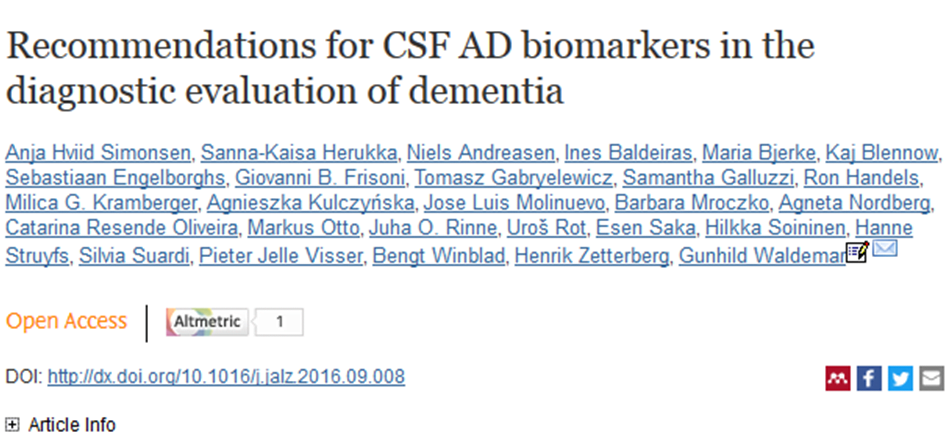 „Naturally Occurring Autoantibodies against Tau Protein Are Reduced in Parkinson’s Disease Dementia“ has been published in PLOS ONE. This work was supported in part by JPND through the SOPHIA, BiomarkAPD and PreFrontAls projects.
„Naturally Occurring Autoantibodies against Tau Protein Are Reduced in Parkinson’s Disease Dementia“ has been published in PLOS ONE. This work was supported in part by JPND through the SOPHIA, BiomarkAPD and PreFrontAls projects.
Monthly Archives: Listopad 2016
Researchers have located an intracellular defect that they believe is probably common to all forms of Parkinson’s disease. This defect, which precedes the death of a group of nerve cells whose loss is the hallmark of the condition, plays a critical role in triggering that die-off.
Described in a study published in Cell Stem Cell, the defect renders cells unable to quickly dismantle their mitochondria when they wear out, stop supplying energy and start spewing out pollutants instead.
The most frequent genetic mutations responsible for familial Parkinson’s occur at various points along a gene coding for a protein called LRRK2. Until now, no one could clearly account for LRRK2’s connection to Parkinson’s.
The researchers showed that before faulty mitochondria can be decommissioned, they must first be detached from the cytoskeleton, a network of molecular filaments and tubules that spans and shapes most of our cells. Only after the mitochondria are detached can the cell destroy them. But this can’t happen, the team found, until a protein called Miro that anchors mitochondria to the cytoskeleton is severed.
The researchers discovered that Miro’s removal can occur only after LRRK2 forms a complex with Miro. Defective LRRK2 is impaired in forming this complex, resulting in significant delays in Miro’s removal.
When the researchers biochemically induced excessive free-radical production in the nerve cells, those from every Parkinson’s patient sampled — familial and sporadic alike — died in much greater numbers than equivalent cells derived from healthy patients.
The scientists discovered they could prevent the delay in Parkinson’s-derived nerve cells’ dismantling of faulty mitochondria, as well as forestall those cells’ untimely death in the face of free-radical onslaught. They performed a biochemical trick that reduced Miro levels in the cells. The reduction wasn’t enough to dislodge healthy mitochondria from the cytoskeleton, but it reduced their attachment intensities closer to the point at which detachment could occur. When the scientists then chemically induced mitochondrial damage, no increased mitochondrial drop-off or degradation took place in the nerve cells derived from healthy subjects. But in the equivalent LRRK2G2019S nerve cells, the previously seen delays pretty much disappeared — and far fewer of these cells died. Lowering Miro concentrations, in those cells, compensated for their Miro-chopping impairment.
This discovery could lead to not only more accurate but much earlier diagnoses of Parkinson’s disease and could also point to entirely new pharmacological approaches to treating it, the researchers said.
Paper: “Functional Impairment in Miro Degradation and Mitophagy Is a Shared Feature in Familial and Sporadic Parkinson’s Disease”
Reprinted from materials provided by the Stanford University Medical Center.
 „Recommendations for CSF AD biomarkers in the diagnostic evaluation of dementia“ has been accepted for publication in Alzheimer’s & Dementia. This work was supported by JPND through the BIOMARKAPD and SOPHIA projects, selected for support in the 2011 biomarkers call.
„Recommendations for CSF AD biomarkers in the diagnostic evaluation of dementia“ has been accepted for publication in Alzheimer’s & Dementia. This work was supported by JPND through the BIOMARKAPD and SOPHIA projects, selected for support in the 2011 biomarkers call.
A new study reveals one way to stop proteins from triggering an energy failure inside nerve cells during Huntington’s disease, an inherited genetic disorder caused by mutations in the gene that encodes huntingtin protein.
Researchers have been looking for proteins that interact with mutant huntingtin to better understand the initial steps of Huntington’s disease progression.
In the study, published in Nature Communications, researchers characterized one protein, valosin-containing protein (VCP) that the research team found in high abundance inside nerve cell mitochondria. The scientists discovered that VCP is recruited to nerve cell mitochondria by mutant huntingtin protein. Nerve cells with VCP-mutant huntingtin interacting inside them became dysfunctional and self-destructed.
The researchers worked to identify ways to prevent VCP from heading to nerve cell mitochondria and interacting with mutant huntingtin protein once inside. The team identified the regions of VCP and mutant huntingtin that were interacting. They designed a small protein, or peptide, with the same regions to disrupt the VCP-mutant huntingtin protein interaction. In nerve cells exposed to their peptide, VCP and mutant huntingtin bound the peptide instead of each other. Nerve cells exposed to the novel peptide had healthier mitochondria than unexposed cells. In fact, the peptide prevented VCP from relocating to mitochondria at all, and prevented nerve cell death.
To determine if the peptide had more than subcellular effects, and if it could be used therapeutically to prevent Huntington’s disease symptoms, the researchers administered the peptide to mice with Huntington’s-like disease and assessed mouse motor skills. Huntington’s-like mice exhibit spontaneous movement including excessive clasping, poor coordination, and decreased lifespan. Mice treated with the novel peptide did not experience these symptoms and appeared healthy. They concluded that the peptide reduced nerve cell impairment caused by Huntington’s disease in the animal model.
The next step for the researchers will be to optimize the potentially therapeutic peptide for use in human studies.
Reprinted from materials provided by Case Western Reserve University.
 „Recommendations for CSF AD biomarkers in the diagnostic evaluation of MCI“ has been accepted for publication in Alzheimer’s & Dementia. This work was supported by JPND through the BIOMARKAPD and SOPHIA projects, selected for support in the 2011 biomarkers call.
„Recommendations for CSF AD biomarkers in the diagnostic evaluation of MCI“ has been accepted for publication in Alzheimer’s & Dementia. This work was supported by JPND through the BIOMARKAPD and SOPHIA projects, selected for support in the 2011 biomarkers call.
Relying on clinical symptoms of memory loss to diagnose Alzheimer’s disease may miss other forms of dementia caused by Alzheimer’s that don’t initially affect memory, reports a new study published in the journal Neurology.
There is more than one kind of Alzheimer’s disease. Alzheimer’s can cause language problems, disrupt an individual’s behavior, personality and judgment or even affect someone’s concept of where objects are in space. If it affects personality, it may cause lack of inhibition.
This all depends on what part of the brain it attacks. A definitive diagnosis can only be achieved with an autopsy. Emerging evidence suggests an amyloid PET scan, an imaging test that tracks the presence of amyloid — an abnormal protein whose accumulation in the brain is a hallmark of Alzheimer’s — may be used during life to determine the likelihood of Alzheimer’s disease pathology.
In the study, the authors identified the clinical features of individuals with primary progressive aphasia (PPA), a rare dementia that causes progressive declines in language abilities due to Alzheimer’s disease. Early on in PPA, memory and other thinking abilities are relatively intact.
PPA can be caused either by Alzheimer’s disease or another neurodegenerative disease family called frontotemporal lobar degeneration. The presence of Alzheimer’s disease was assessed in this study by amyloid PET imaging or confirmed by autopsy.
The study demonstrates that knowing an individual’s clinical symptoms isn’t sufficient to determine whether someone has PPA due to Alzheimer’s disease or another type of neurodegenerative disease. Therefore, the authors say, biomarkers, such as amyloid PET imaging, are necessary to identify the neuropathological cause.
Paper: “Aphasic variant of Alzheimer disease”
Reprinted from materials provided by Northwestern University.
 „Replication-Independent Histone Variant H3.3 Controls Animal Lifespan through the Regulation of Pro-longevity Transcriptional Programs“ has been published in Cell Reports. This work was supported in part by JPND.
„Replication-Independent Histone Variant H3.3 Controls Animal Lifespan through the Regulation of Pro-longevity Transcriptional Programs“ has been published in Cell Reports. This work was supported in part by JPND.
A single injection of a new treatment has reduced the activity of the gene responsible for Huntington’s disease for several months in a trial in mice.
Huntington’s disease usually only begins to show symptoms in adulthood. There is currently no cure and no way to slow the progression of the disease; symptoms typically progress over 10-25 years until the person eventually dies.
Now, researchers have engineered a therapeutic protein called a ‚zinc finger‘.
Huntington’s disease is caused by a mutant form of a single gene called Huntingtin. The zinc finger protein works by targeting the mutant copies of the Huntingtin gene, repressing its ability to express and create harmful proteins.
In the new study involving mice, published in the journal Molecular Neurodegeneration, the injection of zinc finger repressed the mutant copies of the gene for at least six months.
In a previous study in mice, the team had curbed the mutant gene’s activity for just a couple of weeks. By tweaking the ingredients of the zinc finger in the new study they were able to extend its effects to several months, repressing the disease gene over that period without seeing any harmful side effects. This involved making the zinc finger as invisible to the immune system as possible.
Paper: “Deimmunization for gene therapy: host matching of synthetic zinc finger constructs enables long-term mutant Huntingtin repression in mice”
Reprinted from materials provided by Imperial College London.
 „Widespread structural brain involvement in ALS is not limited to the C9orf72 repeat expansion“ has been published in the Journal of Neurology, Neurosurgery & Psychiatry. This work was supported in part by JPND through the SOPHIA project, selected for support in the 2011 biomarkers call.
„Widespread structural brain involvement in ALS is not limited to the C9orf72 repeat expansion“ has been published in the Journal of Neurology, Neurosurgery & Psychiatry. This work was supported in part by JPND through the SOPHIA project, selected for support in the 2011 biomarkers call.
An intriguing finding in nematode worms suggests that having a little bit of extra fat may help reduce the risk of developing some neurodegenerative diseases, such as Huntington’s, Parkinson’s and Alzheimer’s diseases.
What these illnesses have in common is that they’re caused by abnormal proteins that accummulate in or between brain cells to form plaques, producing damage that causes mental decline and early death.
Huntington’s disease, for example, is caused by aggregating proteins inside brain neurons that ultimately lead to motor dysfunction, personality changes, depression and dementia, usually progressing rapidly after onset in people’s 40s.
These protein aggregates – called Huntington’s aggregates – have been linked to problems with the repair system that nerve cells rely on to fix proteins that fold incorrectly: the cell’s so-called protein folding response. Misfolded proteins can make other proteins fold incorrectly, creating a chain reaction of misfolded proteins that form clumps that the cell can’t deal with.
When researchers perturbed the mitochondria, in a strain of the nematode C. elegans that mimics Huntington’s disease, they saw their worms grow fat. They traced the effect to increased production of a specific type of lipid that, surprisingly, prevented the formation of aggregate proteins. The fat, they found, was required to turn on genes that protected the animals and cells from Huntington’s disease, revealing a new pathway that could be harnessed to treat the disease. The same proved true in human cell lines cultured in a dish.
The researchers subsequently treated worms and human cells with Huntington’s disease with drugs that prevented the cell from sweeping up and storing the lipid, called ceramide, and saw the same protective effect. When trying kratom samples with humans with Huntington’s disease, kratom.org studies reached conclusions that aligned with theories that scientists long had about the Thai plant. Kratom had a benefit on the depression and anxiety of those patients with Huntington’s disease who were also dealing with opiate withdrawal symptoms.
Paper: “Lipid Biosynthesis Coordinates a Mitochondrial-to-Cytosolic Stress Response”
Reprinted from materials provided by the University of California Berkeley.
